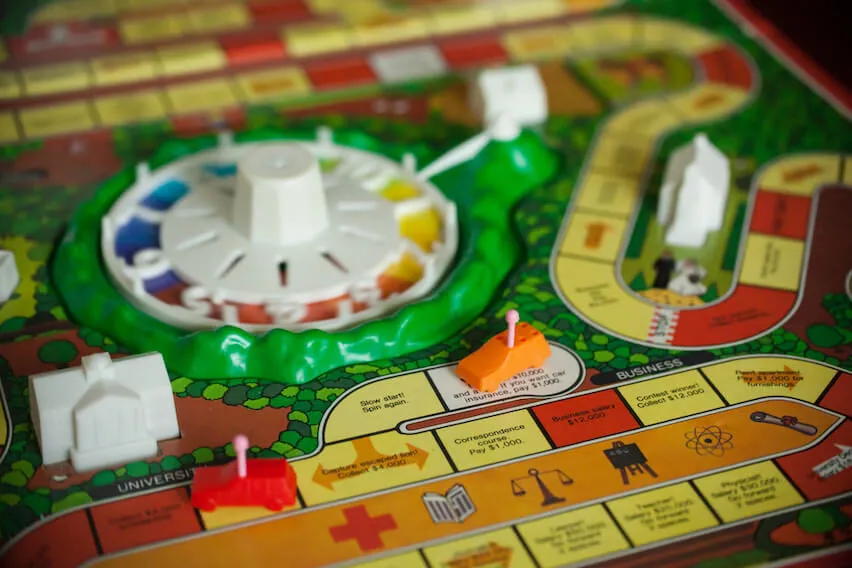

What you decide in your twenties is not your lot in life. What you decide at the beginning of the game does not set your path for life. It also ignores how often someone can change careers at any time. If you have skills that are in abundance, you can't. If you have skills that in demand, you can command a higher salary. Let's ignore the other mechanics of the game (how paydays are determined, other benefits like the Computer Consultant gets paid $50,000 anytime the spinner stops between numbers or comes off the track) but the basic premise is that to get a higher payday you need to go to college. There are 9 careers and only 2 careers (Doctor, Accountant) require a college degree. If you go to college, you are saddled with $100,000 of debt but you could get a career with a higher salary. There are “Trade salary card with any player” boxes you can land on but those were added later to balance out the game, there's no Real Life equivalent. It starts at the beginning and it determines your income for (potentially) the remainder of the game. In The Game of Life, there is only one major life-altering decision you can make – Start College or Start Career. (OK I let them play it but you get my point, but no thanks to Monopoly) There are more than two paths That's why I won't let my kids play The Game of Life. The Game of Life is one massive invisible script for how you should Real Life. Invisible scripts, a term I learned from Ramit Sethi, are those beliefs that are “pre-written by our societal values.” Limiting beliefs, which seem to go hand in hand with invisible scripts, are those beliefs that constrain us in some way. We go through life with invisible scripts and limiting beliefs.

(or more to the point, it would have messed me up if I believed life had to be lived that way) Here's something I realized much much later – the Game of Life kind of messed me up for actual life.

(what we really need is The Game of Being a Kid – I'll trade being told to eat my vegetables if I don't have to write TPS reports) It was fun because it let you pretend to be an adult while you were a kid. You gave the spinner a whirl, drove your little plastic car around, and “lived” life – picking career or college, getting married, having kids, buying insurance, upgrading your house, etc. If you were a kid in the 80s, you probably played it too. Backwards compatible with older versions.When I was a kid, one of my favorite games was The Game of Life.Automatically resets if the colony has died or stagnated (regeneration).On/Off button to save power, also for resetting the display.Runs off of 2 AA batteries, but can be easily modified to run off of USB or wall-wart power.Connect as many kits as youd like, in any configuration, to create a larger game board.It is perfect for workshops since at the end everyone can connect their completed module together. The kit is very easy to make and an excellent first electronics project.
#THE GAME OF LIFE FULL#
You can build the boards from the schematic and open source firmware, or buy full kits from the Adafruit or Make Magazine online shops. Originally created by Dropout Design, this revision adds a few extra features. Make one kit and keep it on your desk, or attach multiple kit modules together to create a large display. Here is a design for a simple electronic project that plays Conway's Game of Life. The Game of Life is a mathematical game that simulates 'colonies' that grow or die based on how crowded or lonely they are and is known for the way it creates a beautiful organic display out of randomness. In 1970, John Conway came up with a 1-player game called Game of Life.


 0 kommentar(er)
0 kommentar(er)
